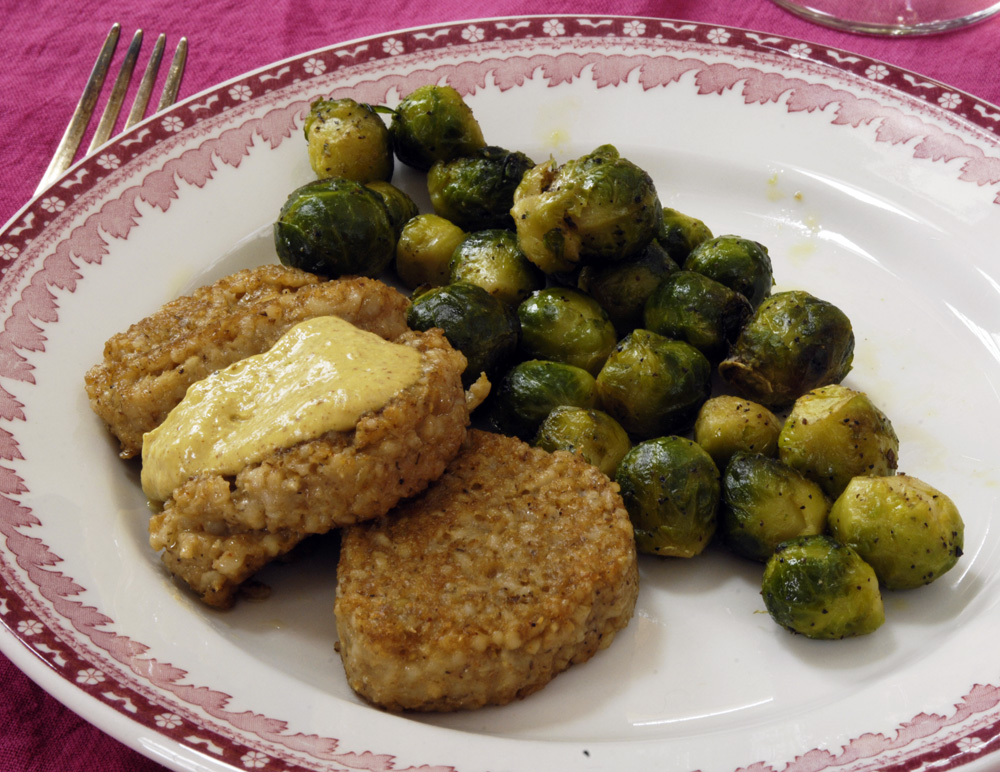
Click here for high-resolution version
Back in January, when I wrote a post about fried barley polenta, I was using organic pearled barley, because that’s what I had at the time. However, pearled barley (though it’s very good) is not really a whole-grain product. Hulled barley is. Today, while it was snowing outside, I did another experiment with barley polenta using organic hulled barley. You can buy organic hulled barley in bulk at Whole Foods. It’s one of the best bargains in the Whole Foods bulk section.
There’s something magical about barley. It sticks to the ribs like nothing else. It’s outrageously healthy, both for the digestive system and for the bloodstream. It’s one of those foods that is pure medicine. No wonder the gladiators ate it. Smart people would figure out a way to make it a staple, using much more barley and much less wheat. The most delicious way to use barley that I’ve figured out so far is to make polenta from barley grits. Once you’ve figured out your method for cracking the barley into grits and working it into polenta, the next step is figuring out ways to season it. I plan to spin it as sausage when it’s served at breakfast (using sage and pepper). And it works great as a binder for vegetable burgers when served at supper. I’m guessing that it also would make a fine raisin pudding. It loves sauces, including gravy. It would make excellent arancini or risotto. It would substitute for meatballs in lots of recipes. It could be combined with soybeans and appropriate seasonings to make a vegan meatloaf. The barley experiments will continue.

Click here for high-resolution version
The photos in this post are digital, using natural light from north-facing windows.

The late queen of Denmark, Ingrid was regularly drinking what she called ‘barley water’.
The strained water from cooking barley, added some juice of a lemon.
She claimed it to very, very refreshening.
At a certain time I tried to make it … well I might not be the best of cooks 🙂
What do you use to get the barley to hold together in a patty like that so you can mold it into shape and, I assume, fry it?
Hi DCS: The barley grits, after cooking, are so sticky that they’ll hold together. I also add some food yeast and seasonings. I roll it up in foil while it’s hot, and it sets up when it cools. Just unroll it and slice it. There’s a photo of that in link to the previous barley post.
Good link on barley that contains other links, including one about barley lemon water:
https://www.thekitchn.com/whats-the-difference-hulled-vs-97116
Link specifically about barley lemon water:
https://www.thekitchn.com/summer-drink-lemon-barley-wate-87795
Barley as part of the food medicine cabinet — a topic that I hope we can discuss more.
Firstly — How would you incorporate the barley into a brothy mushroom soup? Mushroom broth is the only thing that noticeably helps a friend who has suffered from pancreatitis that landed him in the hospital. The only preventive medicine for pancreatitis is certain foods (and quitting alcohol, of course),
So my question: If you’ve already rehearsed a pretty reliable recipe for homemade mushroom soup that yields lots of healing broth — because it starts with a mirepoix plus whole garlic cloves and parsley — how would you incorporate hulled barley?
Throw in two cups of barley and cook it with the the whole stockpot? Or prepare the barley separately since it has to cook longer than pearled barley and then add it, along with its stock, to the mushroom soup?
DCS
Hi DCS: Two cups of dry barley would be a huge amount of barley. It expands tremendously when cooked, and the water to barley ratio (by volume) is at least 3 to 1.
You could soak the barley in the fridge for 24 hours (or more) before cooking to help judge the quantity. But once you’ve worked out just how much barley you need, you need to cook it in the soup stock for at least an hour. Much longer is better. The question is whether you’re just looking for a stock nicely thickened with barley or whether you want to eat a lot of barley. As a stock thickener, I’d say that a third of a cup of dry barley for three quarts of stock would be about right.
As a reference on proportions, you might check some recipes for Scotch broth, which derives the wonderful structure of its broth from a combination of simmered sheep bones and barley. The sheep bones contribute gelatin, and the barley thickens the stock much like flour thickens gravy.
A bowl of Scotch broth that I et once in Edinburgh was the most incredible soup I’ve had in my life. Barley loves peas, so you might also want to add a minor quantity of peas to your mushroom soup.
Yes. Yes. That was the advice I needed. I’m not looking to EAT a lot of barley in this case but to DRINK its essence in a brothy soup. I would add the peas for myself but will leave them out for this particular medicinal application. The broth is the thing. THANKS.
DCS